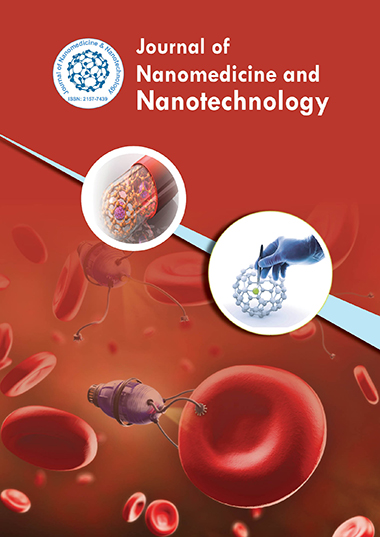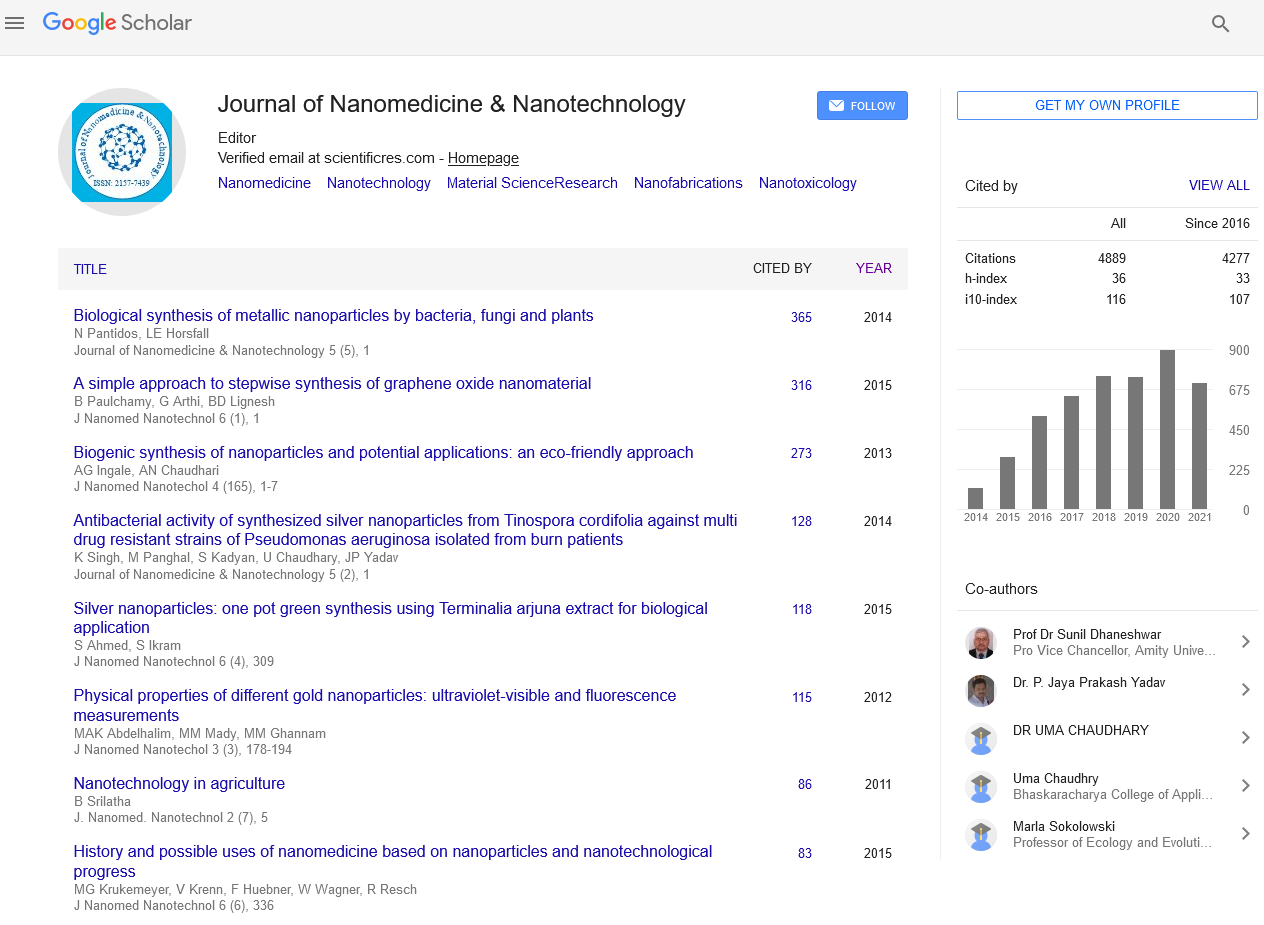Indexed In
- Open J Gate
- Genamics JournalSeek
- Academic Keys
- JournalTOCs
- ResearchBible
- China National Knowledge Infrastructure (CNKI)
- Scimago
- Ulrich's Periodicals Directory
- Electronic Journals Library
- RefSeek
- Hamdard University
- EBSCO A-Z
- OCLC- WorldCat
- SWB online catalog
- Virtual Library of Biology (vifabio)
- Publons
- MIAR
- Scientific Indexing Services (SIS)
- Euro Pub
- Google Scholar
Useful Links
Share This Page
Journal Flyer

Open Access Journals
- Agri and Aquaculture
- Biochemistry
- Bioinformatics & Systems Biology
- Business & Management
- Chemistry
- Clinical Sciences
- Engineering
- Food & Nutrition
- General Science
- Genetics & Molecular Biology
- Immunology & Microbiology
- Medical Sciences
- Neuroscience & Psychology
- Nursing & Health Care
- Pharmaceutical Sciences
Editorial - (2025) Volume 16, Issue 1
Nanostructured Biosensors for Detection of Extracellular Vesicles as Cancer Biomarkers
Abdulrahman Al-Fahad*Received: 01-Jan-2025, Manuscript No. jnmnt-25-28322; Editor assigned: 03-Jan-2025, Pre QC No. jnmnt-25-28322 (PQ); Reviewed: 16-Jan-2025, QC No. jnmnt-25-28322; Revised: 23-Jan-2025, Manuscript No. jnmnt-25-28322 (R); Published: 31-Jan-2025, DOI: 10.35248/2157-7439.24.16.775
INTRODUCTION
Cancer remains one of the most significant global health challenges, with early detection playing a crucial role in improving patient prognosis and treatment outcomes. Traditional diagnostic techniques for cancer often rely on imaging, biopsy, or blood-based biomarkers, which may not always offer the sensitivity, specificity, or non-invasive nature required for optimal early detection. Recent advancements in cancer biomarker discovery have highlighted extracellular vesicles (EVs) as potential candidates for early-stage cancer diagnostics. EVs, which include exosomes, microvesicles, and apoptotic bodies, are membrane-bound structures secreted by cells and carry a cargo of proteins, lipids, nucleic acids, and metabolites that reflect the molecular characteristics of their parent cells. Due to their ability to circulate in bodily fluids like blood, urine, and saliva, EVs offer an ideal platform for non-invasive cancer diagnostics. To take full advantage of EVs as cancer biomarkers, highly sensitive and specific detection methods are required. Traditional techniques for EV detection, such as flow cytometry and western blotting, are often cumbersome, time-consuming, and lack the sensitivity needed for early-stage detection. Nanotechnology offers innovative solutions through the development of nanostructured biosensors that can detect EVs at extremely low concentrations, providing a more effective and efficient approach for cancer diagnostics. This article explores the potential of nanostructured biosensors for the detection of extracellular vesicles as cancer biomarkers, focusing on the mechanisms, advantages, challenges, and future directions of this promising diagnostic tool [1].
MECHANISMS OF NANOSTRUCTURED BIOSENSORS FOR EV DETECTION
Nanostructured biosensors leverage the unique properties of nanomaterials, such as their high surface area, biocompatibility, and the ability to functionalize their surfaces with specific recognition elements. These properties enable the design of highly sensitive and selective sensors for detecting target biomolecules, including EVs, which are typically present in very low concentrations in biological fluids. The detection of EVs using nanostructured biosensors typically involves the use of surface-functionalized nanoparticles or nanomaterials to capture and identify EVs. A common approach is to functionalize the surface of nanoparticles, such as gold nanoparticles (AuNPs), carbon nanotubes (CNTs), or magnetic nanoparticles (MNPs), with specific ligands, antibodies, or aptamers that bind to proteins or surface markers present on the EVs. These surface markers, such as tetraspanins (CD63, CD81) or integrins, are often overexpressed on the surface of cancer-derived EVs, making them suitable targets for biosensor-based detection [2]. Once EVs bind to the functionalized nanostructures, the biosensor detects changes in the nanomaterialâ??s properties, which can be translated into a detectable signal. For example, changes in the optical properties of gold nanoparticles (e.g., localized surface plasmon resonance) can be used to detect the presence of EVs. Similarly, magnetic nanoparticles can be used in conjunction with magnetism-based detection methods, where the binding of EVs alters the magnetic properties of the nanoparticles, allowing for quantification. Other techniques, such as electrochemical or piezoelectric sensors, take advantage of the changes in electrical conductivity or mechanical properties caused by EV binding [3]. Nanostructured biosensors also enable highly sensitive detection due to their ability to amplify the signal from small numbers of EVs. This amplification can be achieved through the use of nanomaterials that enhance the interaction between EVs and the recognition elements, or by employing strategies such as enzymatic amplification or signal cascades. The high surface area and small size of the nanomaterials allow for a greater number of EVs to be captured, resulting in stronger and more reliable signals, even in complex biological samples [4].
ADVANTAGES OF NANOSTRUCTURED BIOSENSORS FOR EV DETECTION
The use of nanostructured biosensors for EV detection offers several significant advantages over conventional diagnostic methods. One of the most notable benefits is their sensitivity. Nanostructured materials have a high surface area-to-volume ratio, which increases the likelihood of interactions between the biosensor and EVs. This allows for the detection of even low-abundance biomarkers, such as EVs, with higher precision and at earlier stages of cancer. This level of sensitivity is particularly crucial for detecting cancers before symptoms appear or when the tumor is still small, offering an opportunity for early intervention. Another advantage is the potential for non-invasive and real-time monitoring of cancer progression. As EVs can be isolated from easily accessible bodily fluids, such as blood, urine, and saliva, the use of nanostructured biosensors for EV detection enables less invasive sampling compared to traditional tissue biopsies. This makes it possible to monitor disease progression, track treatment response, and detect relapses in a less invasive and more convenient manner for patients [5]. Nanostructured biosensors are also versatile and can be adapted for use in various detection platforms. For example, optical sensors, electrochemical sensors, and magnetic resonance sensors can all benefit from the integration of nanomaterials, depending on the specific application. This flexibility allows for the development of tailored biosensor systems that meet the needs of different clinical and research settings. The high specificity of nanostructured biosensors for EVs is another key advantage [6]. The ability to functionalize the surface of nanoparticles with antibodies or aptamers targeting specific surface markers on cancer-derived EVs ensures that only relevant EVs are captured and detected. This reduces the potential for false positives and enhances the accuracy of the diagnostic tool. Furthermore, nanoparticles can be designed to selectively capture and differentiate between cancerous and non-cancerous EVs, further improving the specificity of the detection system.
CHALLENGES AND LIMITATIONS
While nanostructured biosensors offer great potential for the detection of EVs as cancer biomarkers, several challenges must be addressed to realize their full clinical potential. One significant challenge is the complexity of biological samples. Bodily fluids such as blood contain a variety of molecules, including proteins, nucleic acids, and other extracellular vesicles, which can interfere with the detection of target EVs. The ability of nanostructured biosensors to selectively capture cancer-derived EVs in the presence of these other components requires the careful optimization of the recognition elements and sensor design to minimize nonspecific binding and ensure accurate results [7]. Another challenge is the standardization of EV isolation and characterization methods. The lack of universally accepted protocols for EV isolation means that the purity and concentration of EVs can vary between samples, which may affect the reliability and reproducibility of biosensor-based detection. The development of standardized methods for EV isolation and pre-concentration is essential to ensure consistent results across different samples and platforms. Additionally, although nanostructured biosensors offer excellent sensitivity, they can sometimes suffer from issues related to signal stability and reproducibility. The binding of EVs to nanoparticles can lead to variations in the signal over time, particularly in complex biological environments where multiple interactions may occur. Therefore, the development of more robust and reliable detection platforms that maintain signal consistency is a critical area for further research [8].
FUTURE DIRECTIONS
The potential for nanostructured biosensors in the detection of EVs as cancer biomarkers is vast, and ongoing research is focused on overcoming the current challenges to improve their clinical utility. Future research efforts should focus on optimizing sensor designs, improving sensitivity, and developing more specific recognition elements to capture rare and low-abundance EVs. The integration of nanostructured biosensors with other diagnostic technologies, such as microfluidics and multiplexed detection systems, may allow for even more comprehensive and efficient cancer detection [9]. Additionally, advances in nanomaterial chemistry and surface engineering will allow for the design of nanoparticles that are more stable, biocompatible, and capable of interacting with a wider range of biomarkers. Personalized cancer diagnostics could also benefit from the ability of nanostructured biosensors to differentiate between various subtypes of cancer, based on the specific profile of EV surface markers [10].
CONCLUSION
In conclusion, nanostructured biosensors represent a highly promising and innovative tool for the detection of extracellular vesicles as cancer biomarkers. By leveraging the unique properties of nanomaterials, these biosensors offer the potential for highly sensitive, specific, and non-invasive cancer diagnostics. With continued advancements in nanotechnology and biosensor design, these systems could play a crucial role in early cancer detection, monitoring treatment response, and enabling personalized medicine strategies in the near future.
REFERENCES
- Ranade A R, Zhang H, Drueckhammer D G. 3D-QSAR Models for Arylcarboxamides as Potent and Selective Human Beta 3 Adrenergic Receptor Agonists. J Chem Inf Model. 2018; 58(7): 1476-1487.
- Bai Y, Li Y, Zhang G, Hou X. Understanding the mechanisms of graphene-based nanomaterials as drug carriers: a theoretical perspective. Phys Chem Chem Phys. 2020; 22(29): 16544-16556.
- Garg S, Liao W, El-Kadi AO. Understanding the interaction of dietary polyphenols with mammalian drug metabolizing enzymes. Curr Drug Metab. 2020; 21(6): 416-429.
- Zhang Y, Zhang R, Su H. Interaction of ligand-bound nanoparticles with cell membranes: from specific binding to nonspecific penetration. Langmuir. 2019; 35(3): 677-688.
- Shi Y, Zhao R, Zhang Q, Wei Y, Zhao Y. Molecular Dynamics Simulation-Guided Rational Design of Polymer Nanocarriers for Drug Delivery. Nanoscale Res Lett. 2019; 14(1): 372.
- Li C, Li Q, Zeng Z, Zhou X. Dispersions of hydrophobic magnetite nanoparticles in nonpolar solvents with different surfactants: the effect of surfactant chain length and surfactant concentration. J Colloid Interface Sci. 2019;539: 567-577.
- Zhang S, Bellinger A, Genshaft A. A bloodâ??brain barrierâ??penetrating gut-microbe-derived molecule that enhances amyloid beta deposition and cognitive impairment in a mouse model. Science Advances. 2021; 7(23): eabf1773.
- Tong R, Chiang HH, Kohane DS. Photoswitchable nanoparticles for in vivo cancer chemotherapy. Proc Natl Acad Sci. 2020; 110(46): 19048-19053.
- Sarvi F, Mahmoodzadeh A, Kiani M. A novel mathematical model for the effective drug administration and the drug concentration in brain tumor. J Drug Deliv Sci Technol. 2021; 61:102275.
- Jiang H, Du L, Li L. Multiscale modeling and experimental study on the self-assembly of telo-dendrimers. J Mol Model. 2021; 27(1): 1-13.
Indexed at, Â Google Scholar, Crossref
Indexed at, Google Scholar, Crossref
Indexed at, Google Scholar, Crossref
Citation: Al-Fahad A (2025) Nanostructured Biosensors for Detection of Extracellular Vesicles as Cancer Biomarkers. J Nanomed Nanotech. 16: 775.
Copyright: ©2025 Al-Fahad A. This is an open-access article distributed under the terms of the Creative Commons Attribution License, which permits unrestricted use, distribution, and reproduction in any medium, provided the original author and source are credited.


